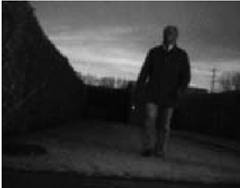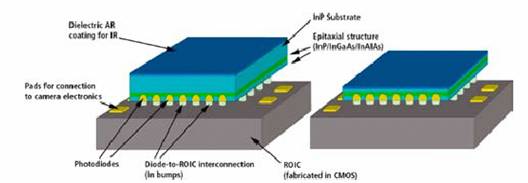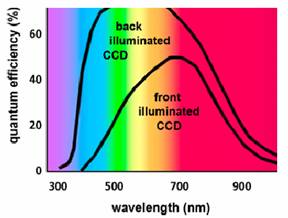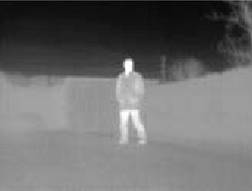|
||||||||||||||||||||||||||||||||||||||||||
|
||||||||||||||||||||||||||||||||||||||||||
Night Vision Camera Combines Thermal And Low Light Level Images
By Raf Vandersmissen, XenICs NV, Leuven, Belgium and Marc Fimeri, Adept Electronic Solutions, Australia
Even on moonless but starlit nights, highly sensitive InGaAs cameras will produce good images using short wavelength infrared. By thinning the image sensor chip light passes right through the substrate and allows the wavelength range of these detectors to be extended into the visible spectrum to span 400 – 1700 nm. They offer good quality optical images even on nights when the human eye can see nothing and far outperform thermal sensors for sharpness of image.
IinfraRed imaging is already used successfully in many technical/scientific fields. Its development like that of other imaging technologies is heading in the direction of higher resolution, increased sensitivity and higher speed. Added to this is the multispectral capture across multiple IR spectral ranges (Figure 1). These ranges begin with short wavelength infrared (SWIR) which, with its wavelength of 0.9 – 1.7 μm, follows on directly from the visible spectrum ( VIS) and is therefore also called near infrared (NIR). This is followed by mid-wavelength infrared (MWIR), which ranges from 3 – 5 μm. Finally long wavelength infrared (LWIR), from approx. 8 – 14 μm, is also gaining in importance for various kinds of analysis.
As well as the improved performance of IR image sensors, their manufacture with common industry processes on standard production lines ensures steady price reduction. This is opening up further more price-sensitive application areas including high volume applications to IR array sensor technology.

Figure 1: New infrared camera types and their combinations are conquering wider spectral ranges, which are classified according to the water vapour absorption bands in the atmosphere.
Turning night into day
In particular the high sensitivity and dynamics of SWIR image sensors using InGaAs technology predestines them for use in low light level cameras. These are used wherever insufficient light renders the use of normal cameras impossible. This type of camera is used for monitoring at dusk, dawn or night time, e.g. airport, building or site surveillance (security services), for scientific applications in astronomy, meteorology, animal observation and behavioural research, as well as in various military applications and undercover observations. In addition when there is insufficient daylight, the phenomenon of airglow can be utilized. Airglow occurs as weak luminescence in the upper region of the earth’s atmosphere through selective absorption of the UV and X-ray spectrum of sunlight in air molecules and atoms. The biggest share of airglow comes from the air layers at 70 – 300 km up. Of particular significance here is the photochemical dissociation, occurring in the ionosphere, of oxygen molecules into two oxygen atoms each in daylight, which then later – partly at night time – recombine into O2 and give-off light rays. Figure 2 shows the glow, which is also visible from space during the day. At night the brightness of this atmospheric residual light is 5-7 times greater than starlight. It spans virtually the whole SWIR range from 1.0 – 1.7 μm.

Figure 2: Airglow as a thin blue line above the earth’s horizon, photographed in pseudocolor during the Clementine mission 1994 [1]. The bright spots on the earth’s surface are illuminated urban areas (image: Naval Research Laboratory).
With their maximum sensitivity of 0.9 – 1.7 μm, SWIR cameras using InGaAs technology are perfectly suited to exploiting the airglow phenomenon. They also “see” objects very clearly on moonless nights (Figure 3). The fact that the airglow from the entire sky is emitted equally in all latitudes is a big advantage with it.

Figure 3: Airglow illumination was enough for this shot on a moonless, starlit night with a sensitive SWIR camera.
SWIR imaging occurs in a similar way to imaging in the visible wavelength range, because it uses the light reflected by the object. This makes it easier to interpret and analyse scenes compared compared to images taken with thermal detectors. As a result of the reflective principle images from SWIR cameras based on InGaAs also show shade and contrast, and are comparable in resolution and detail with normal images under visible light. Objects in airglow are thus relatively easy to recognize.
A particular benefit of SWIR InGaAs cameras is that they image through conventional glass. Simple glass optics therefore replace lenses made from expensive special materials such as germanium, silicon or zinc selenide as is the case for thermal detectors. Moreover these kinds of cameras, unlike thermal IR cameras or SWIR cameras with InSb or HgCdTe detector arrays, require neither a lens shutter nor expensive cryo-cooling of the array. Without these components the reliability increases, the costs, overall size and weight fall, and the cameras are less sensitive to vibrations. For night vision applications SWIR InGaAs cameras can work with thermoelectrically cooled array sensors, or even manage without any cooling at all [2]. Their growing and varied use in security applications documents the rapid progress of SWIR technology – with ever increasing performance in ever shrinking packages.
Thinner chips extend the spectrum
The structure of a current SWIR image sensor in InGaAs technology is shown in Figure 4 on the left: The infrared photodiodes are produced on an InP epi-substrate about 125 μm thick. Because this technology is not especially well suited to implementing readout circuitry, the photodiode array is assembled with flip-chip technology on a silicon based CMOS chip, which carries the readout integrated circuit (ROIC). The electrical contact is provided by Indium bumps [3]. The illumination then occurs through the InP substrate, although this absorbs all light in the visible spectrum up to 0.9 μm.

Figure 4: Thinning of the substrate turns an InGaAs SWIR camera chip (left) into a broadband VISWIR image sensor (right).
There are however a whole range of applications for which it is necessary or desirable to capture not just the SWIR but also the VIS spectrum with a single “VISWIR“ sensor. A typical example is coupled landing aids in air traffic operations, which consist of an LWIR sensor (in the range 8 – 14 μm) for thermal radiation and a detector in InGaAs technology for SWIR, which in turn effectively captures the light from the incandescent bulbs of the landing lights in the range between 0.9 and 1.7 μm. However to increase safety and reliability, these kinds of landing lights are increasingly being replaced by energy saving light sources with LEDs, which mainly emit rays in the visible spectrum and hardly in NIR. It is therefore expedient to extend the sensitivity range of SWIR sensors into the visible spectrum.
Because the strong absorption of visible and NIR (up to 0.9 μm) light by the substrate has a detrimental effect, the substrate is made much thinner: To ensure safe thinning of the substrate without damaging the InGaAs detector, additional layers of InGaAsP are introduced just below the photodiodes, which in the InP environment act as an etch stop. Subsequent etching with hydrochloric acid (HCl) removes the InP epi substrate selectively and precisely as far as the InGaAsP etch stop layer. This thins the sensor chip from 125 μm to just 5 μm (Figure 4, right), making it transparent for visible light [4], so that the sensor can pick up the broad wavelength range of 0.4 – 1.7 μm (Figure 5). The InGaAs sensor for the VISWIR range is assembled on the CMOS readout circuitry in the established way with a flip chip bonder, and prior to etching.

Figure 5: Already proven since CCD times: A thinned, backlit sensor chip captures a wider spectrum.
Spectrally combined detection
For night vision applications, the SWIR imaging with InGaAs technology is enhanced with thermal imaging cameras for MWIR and LWIR in the form of uncooled micro bolometers or cooled infrared cameras. Their thermal detectors only show the presence of warm objects against a cooler background (Figure 6). In combination with thermal images, SWIR cameras thus simplify the identification of objects which in the thermal image alone are more difficult to recognize.

Figure 6: Thermal imaging from an uncooled micro bolometer camera can enhance VISWIR images with self radiating objects.
The sensor elements of micro bolometer cameras for LWIR are made up of IR absorbing conductors or semiconductors, whose radiation dependent resistance is measured. Because polysilicon is also suitable as an absorber, they can also be made from polysilicon as MEMS [5] and combined with evaluation circuits in CMOS technology.
Real time images from both spectral bands can then be digitally processed and – even more importantly - also overlaid. The systemic fusion of SWIR and LWIR thus allows selection of the image best suited to a given usage situation. LWIR generally proves of value for detecting people or vehicles based on their thermal emission. SWIR images offer additional advantages when visual recognition, for instance in undercover investigations, is required.
Versatile applications
With their extended optical characteristics, such cameras thus open up a multitude of industrial and security related application possibilities, such as hyperspectral imaging, laser beam profilometry, nightvision enhancement in road and air traffic, chip inspection in semiconductor manufacturing, thermal imaging in a temperature range of 200 – 800°C, online process control, and medical electronics.
Special water cooled versions reduce the effect of vibrations from the cooling fan for microscope applications, and are also easier to use in dusty environments. Other typical fields of application include EVS landing systems, building security, public places or authorities, monitoring industrial objects such as factories or power stations, border controls, as well as special reconnaissance missions and rescue operations. VISWIR InGaAs cameras also offer conceptual ideas for night vision aids in cars. As a relatively new application, IR systems have great potential in security for overland transport fleets, or on ferries and yachts. Applications for volume dependent traffic guidance systems are in development. Industrial application areas lie in research and development, in real time monitoring of high temperature production processes or, for example, in the maintenance of aircraft with regard to the performance of electrical, hydraulic and pneumatic systems, such as in turbine inspection.
References:
[1] www.cmf.nrl.navy.mil/clementine
[2] B. Grietens, R. Vandersmissen, J. Bentell, Ungekühlte InGaAs-Arrays für kompakte Hochgeschwindigkeits - Kameras im nahen Infrarot , Photonik 5/2005, p. 76-78
[3] J. John, L. Zimmermann, P. Merken, G. Borghs, C.A. Van Hoof, S. Nemeth, Extended backsideilluminated InGaAs on GaAs IR detectors , Proc. SPIE Vol. 4820, p. 453–459, 2003
[4] D. Göhring, Digitalkameratechnologien , Technische Informatik, Humboldt University Berlin, 2002
[5] V.N. Leonov, N.A. Perova, P. De Moor, B. Du Bois, C. Goessens, B. Grietens, A. Verbist, C.A. Van Hoof, J.P. Vermeiren, Micromachined poly - SiGe bolometer arrays for infrared imaging and spectroscopy , Proc. SPIE Vol. 4945, p. 54–63, 2003
Adept Electronic Solutions are 'The Machine Vision and Imaging Specialists' and distributor for XenICs products in Australia and New Zealand. To find out more about this article or any XenICs product please email us at: adept@adept.net.au, call us at Perth (08) 92425411 / Sydney (02) 99792599 / Melbourne (03) 95555621 or use our online contact us form.
|
If you like this page, please recommend and share it. |
|||
| More | |||



